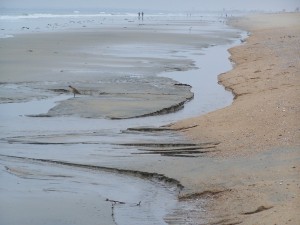Bait Presentation At The Beach
I’ve always said that the most important thing in surf fishing is having a sharp hook. So the second most important thing must be bait presentation. Presenting your bait in the most natural manner so that fish don’t know the difference between a bait with a hook in it and one without a hook is guaranteed to catch you more fish. More importantly, hooking your bait so it looks like it just crawled out of the sand will not only help you catch more fish but is sure to help you catch big fish too.
Here are a few rules that I like to follow that help me weed out the small ones and attract the biggest fish to my bait: Make sure that your bait is correctly positioned upon the hook so it does not spin. Check your bait frequently while fishing and adjust it when necessary. Always place your bait so it lays flat on the hook. Any curve in your bait will make it spin and therefore much less attractive to fish. After hooking your bait pull it through the water in front of you to make sure it doesn’t spin.
Match your bait (both natural and artificial bait) in both size and color to what is currently living in the area you fish. This will mimic the natural size and color of forage. If the crabs in the area are green and brown or the clams orange and red, try those colors. To be most effective, always carry more than one type of bait and know how to use them.
Fan cast: cast straight, cast right and cast to the left at multiple angles to cover the largest area as you search for fish. It’s always easier for the fisherman to find fish than it is for fish to find you.
Use the sharpest thin wire black hook possible. Always be sure you are using the sharpest hook possible. I said that twice because it’s soooooo important! I like to use the following hooks for surf fishing: For small baits like crabs and grubs I like to use a #1, 2 or 4 Owner mosquito light, Gamakatsu split shot or Mustad ultra point octopus hooks. For longer baits like worms or ghost shrimp I prefer a #2, #4 Mustad sproat or kahle hook.
The night before your surf fishing adventure take a little time to tie several lengths of leader placing them on a leader holder. Use four or six pound fluorocarbon leader, a small black barrel swivel and a sharp hook. This way you’ll be ready once you hit the beach and not wasting time tying leaders while the fish are biting.
After casting out, always be sure to keep your line tight to the sinker by reeling up any slack. This will help you to feel the bite and catch more fish. It will also help prevent your line from fouling in the surf and give your bait a much more realistic presentation.
Once you’ve cast out, try reeling the bait in slowly using a stop and start motion with your reel. Vary the speed of your retrieval. When using lures try a very fast and slow retrieval speed as well. Also, utilize a sweep to the side motion, then reel up slack and repeat. This stop and start motion entices fish to follow and strike. Let the fish tell you which retrieve style to utilize. Once you get bit remember what action it was that convinced the fish to strike.
You will always catch more fish if your line is tight and straight in front of you. If there is a long-shore current, pulling your line up or down the beach, try this technique: Cast your bait up into the current and let the drift push your bait down the beach. As your bait moves down the beach walk along to keep the line in front of you by reeling in any slack. Once the bait comes too close to shore, reel in, walk up the beach and repeat. Be aware that fish will frequently be foraging in the inshore trough that may be just a few feet in front of you. Don’t give up on your retrieval until you see your bait on the sand in front of you.
If, after fan casting an area you don’t find fish, move down the beach. I usually move about 100 yards, observing the water as I go for indications of fish, structure or eddy currents. I try fan casting and moving until I find biting fish. Remember, fish move frequently and may congregate in schools to feed; you’ll also need to move for improved success.
Check your main line and leader frequently for knots and damage that may occur from contact with rocks or structure as well as the abrasion that catching fish produces. Also inspect your knots after catching a large fish. There is nothing more disappointing than hooking into the fish of a lifetime only to loose it due to a line or knot failure. If you find any damage, replace the leader, as it is your direct connection to the fish.
Be continuously observant about exactly what you were doing when the fish took your bait. How far out, what angle, speed of retrieval, any currents present, is there a trough, sandbar or structure, color of water, etc.
By using a few simple presentation techniques your bait will take on a more natural look and become more effective for catching the bigger fish in the surf. Treat every outing as a learning experience and you are certain to become a more proficient angler while all the while increasing your enjoyment of this great sport.

